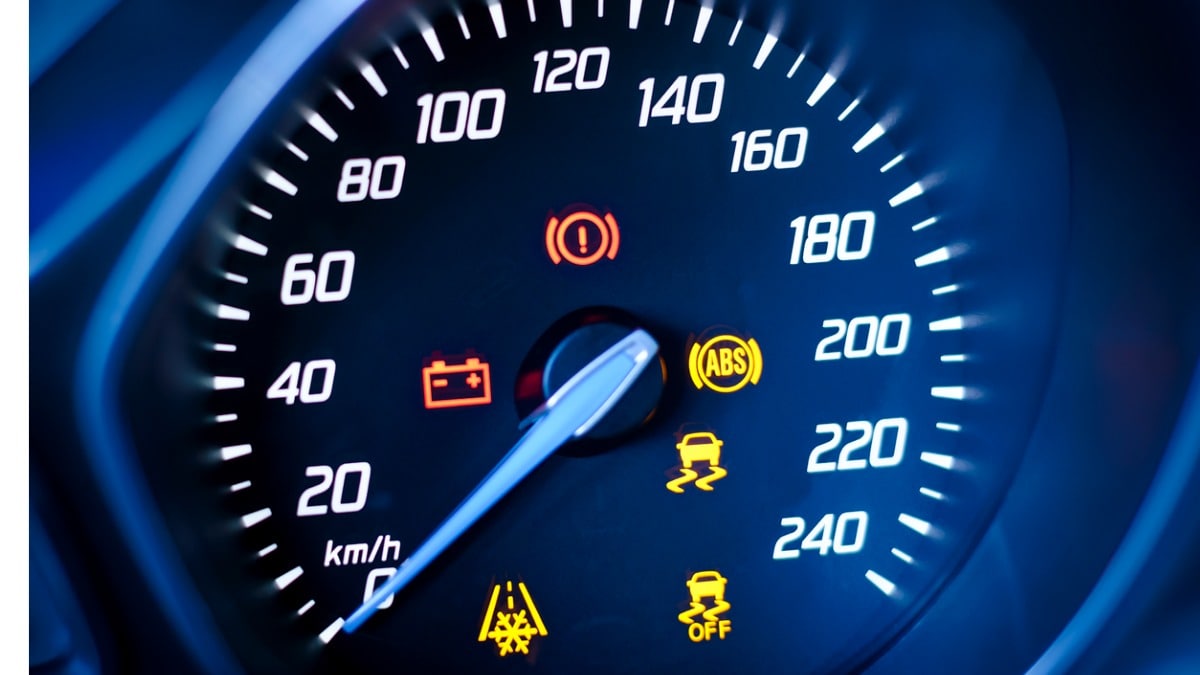Quick Facts About Car Dashboard Warning Lights
- Red dashboard warning lights require immediate action by the driver.
- Orange, Yellow, or Amber warning lights advise the driver of a situation or issue requiring attention. Green or Blue warning lights remind the driver that a feature or system is operating.
- When your check engine light illuminates, do not ignore the warning.
Very few things send a spike of cold fear into a driver’s heart as the sound of a warning ding or beep signaling something amiss when glancing at the gauge display and discovering one or more illuminated, blinking warning lights.
There is no such thing as a good time for a warning light to signal a problem. The interruption of dashboard warning lights is an inconvenience at best and a downright emergency at worst. Managing the angst might be as simple as recognizing what that warning light signifies without pulling to the side of the road to consult the car’s owner’s manual. So, let’s get you schooled on the most common warning lights and their meanings.
- What Do Car Dashboard Lights Mean?
- Common Dashboard Warning Lights and What They Mean
- How to Reset Car Dashboard Warning Lights
What Do Car Dashboard Lights Mean?
Dashboard warning lights illuminating don’t always signal an emergency or even a problem. For example, they all illuminate when you start your car, indicating that all systems are functioning. After that startup phase, each dashboard light serves one of three functions.
- Some dashboard lights signify a system is engaged and functioning.
- Others illuminate briefly to provide a situational warning.
- Another set illuminates when a system is malfunctioning or not working at all.
Although this sounds a bit complicated, carmakers use universal color coding to help drivers quickly evaluate the urgency of an illuminated dashboard light. Consequently, a driver can quickly discount some lights while recognizing the graver warnings of others.
- Red or Blinking — Red and blinking dashboard lights are at the top of the warning-light food chain. Signaling a legitimate emergency, they only activate when immediate action is required. For instance, when the red seatbelt light activates, someone needs to buckle up. If the red door-ajar light illuminates, a door requires proper closure. Activation of the red engine temperature warning light means the engine is overheating. A red warning light means whatever the issue is, it must be immediately addressed. In some cases, like the engine temperature light or oil pressure light, a driver’s response should be to pull off the roadway as soon as safety allows. To continue driving might do irreparable and expensive damage.
- Orange/Yellow/Amber — This group of lights will be either orange, yellow, or amber, depending on the car model. We will lump them together going forward as orange. No matter in which shade they appear, think of them as advisory. They mean that something requires the driver’s attention. They don’t signal a current emergency but rather alert the driver to some issue or situation. If it’s an issue with the catalytic converter, the orange check engine light activates. If the stability control or traction control activates, the appropriate orange light activates as orange.
- Green and Blue — Warning lights illuminating as green or blue are function lights, assuring you that whichever system they represent is operating appropriately. When your car’s headlights are on, that dashboard light illuminates green. As do the turn signals when they are functioning. The headlight high-beam indicator is blue.
Common Dashboard Warning Lights and What They Mean
Below, we list standard dashboard lights, their meaning, and what action the driver should take. We have arranged them in color order, beginning with the most severe: Red, Orange, and Blue/Green. We have also included color images of each warning light.
PRO TIP: Depending on the age or make of a vehicle, the warning lights may be different. If you are unsure what a warning light means, consult your car owner’s manual.
1. Oil Pressure Light

The red oil pressure warning light might indicate a low engine oil level in the shape of an old oil can with a drop of oil dripping from its spout. That being the case, you can buy a can of the appropriate grade of motor oil and top off the level. If this extinguishes the warning light, you should be good to go. On the other hand, if the oil pressure light reactivates after adding oil, you probably have a much bigger problem, like an engine leak, a failed oil pump, or a bad piston ring. Driving a vehicle for any extended period with the oil pressure light illuminated could severely damage the engine’s inner workings.
2. Engine Temperature
Shaped like a partially submerged thermometer, the engine temperature light can illuminate blue or red. If it activates red, it indicates the engine is overheating. The cause may be traced to coolant (antifreeze) levels or some more significant issue, like a failed water pump. In any case, you don’t want to drive any distance once this light activates, particularly if it’s blinking. Pull over and call for help.
PRO TIP: In some vehicles, the engine temperature light will activate blue while the engine is warming up. The blue temperature light will extinguish once the engine reaches its normal operating temperature.
3. Battery

Unmistakably shaped like a battery, this red warning light indicates that something within the vehicle’s charging system has failed or is failing. It could be the battery, alternator, battery cable, or other electrical system components. Ignoring this light means the charging system will eventually fail. Leaving you to wander around asking other drivers if they have jumper cables.
RELATED: How To Jump-Start a Car Battery
4. Brake System
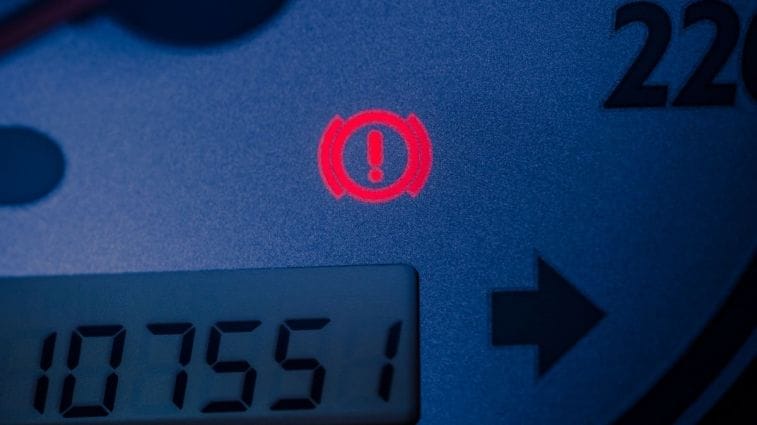
The light is an exclamation point surrounded by a circle inside parentheses. Once the vehicle is started, it will remain illuminated to alert the driver if the parking brake is engaged. However, it can also indicate worn brake pads, low brake fluid levels, or more pressing problems. If topping off the brake fluid doesn’t extinguish this light, it’s time to get the system serviced.
MORE: Use our brake cost estimation tool to determine how much it costs to repair or replace them in your vehicle.
5. Seat Belt Reminder
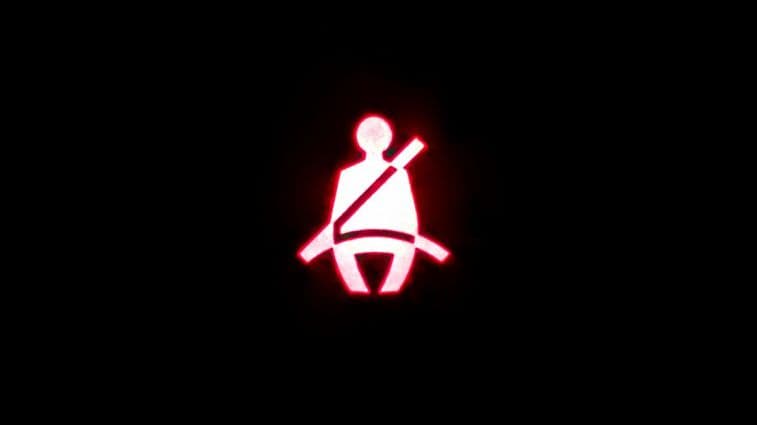
Appearing as the silhouette of a person buckled into a seat, this light activates and remains activated until the driver and front-seat passenger are buckled in. Usually, an audible alert will sound, as well. No mystery here. When illuminated, this light means buckle up.
6. Airbag Indicator
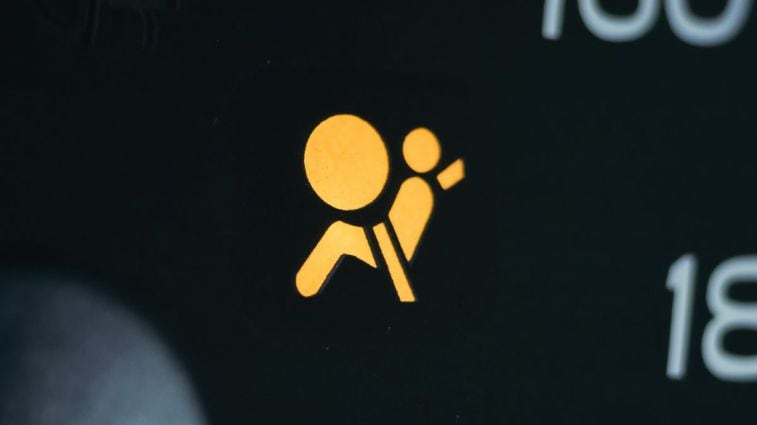
Presenting as the profile silhouette of a seated passenger with a ball in their lap, this light’s activation indicates an issue with a specific airbag or the entire airbag system. The vehicle will continue to operate normally; however, airbags have been proven to help save lives in crashes. Have a trained technician troubleshoot and fix the problem ASAP.
7. Door Ajar
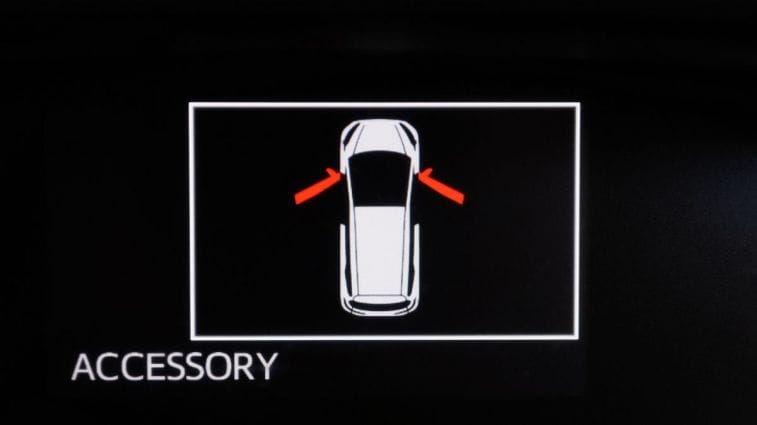
To alert the driver a door isn’t firmly closed and sealed, a warning light with an outline of a bird’s-eye view of the top of a car with an open door or doors activates. Some more sophisticated systems will show the door in question, while others will show an open door or doors. This calls for checking all doors and firmly closing the appropriate door.
8. Check Engine Light
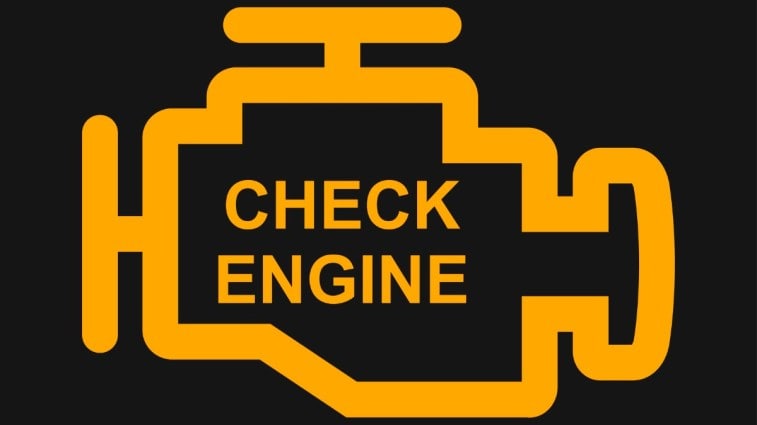
Usually, an orange outline of an engine this light might illuminate for various reasons. Some are as innocuous as a loose fuel-filler cap, loose wiring, or a failed solenoid. However, the reason might be more sinister, like overheating. If the cause (a loose fuel-filler cap) isn’t apparent, a diagnostic test of the On Board Diagnostic (OBD) system will probably be required to determine the cause. Just because the vehicle seems to operate normally doesn’t mean you should ignore the warning. It could indicate a deeper issue that, if left unattended, will reveal itself as a bigger problem down the road. Moreover, if the check engine light is red or blinking, pull the vehicle over as soon as it’s safe and turn off the engine.
PRO TIP: In some vehicles, the check engine warning light actually says “CHECK ENGINE.”
9. Tire Pressure Monitoring System
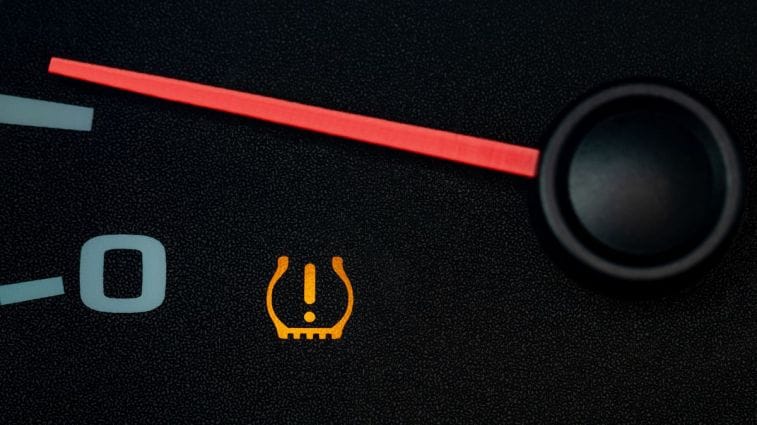
Activation of the orange exclamation point surrounded by two-thirds of a circle warning light indicates an issue with the tire pressure monitoring system (TPMS). Although it could mean some glitch within the system itself, more often than not, it indicates one or more tires are underinflated. Newer models with a more sophisticated TPMS will display a graphic with all four tires, highlighting the underinflated tire or tires. Some displays will even show each tire’s air pressure per square inch (psi). You may need to scroll around different screens on the vehicle’s driver information display to find that more detailed display. Bringing the problem tire back up to the appropriate air pressure should deactivate the warning light after a few miles of driving. If it doesn’t, it may indicate a damaged tire.
PRO TIP: On many vehicles, the recommended tire air pressure is displayed on a sticker inside the driver’s door and in the owner’s manual.
10. Transmission Temperature
Shaped like a thermometer inside a gear, the transmission temperature light illuminating is a sign the transmission is overheating. Low transmission fluid, failing parts, or heavy towing are the common causes. Despite it being orange, it should not be ignored. You should immediately rest the transmission or get it to a service center if the light remains activated.
11. Low Fuel
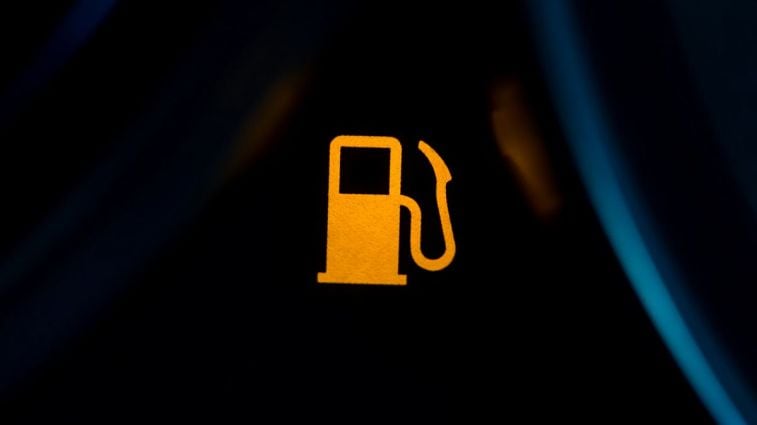
In case you’ve been ignoring that dropping gas gauge indicator, the low fuel light activates to alert you it’s time to top off the gas tank. It’s cleverly designed in the shape of a gas pump.
PRO TIP: As you pull into the gas station, if you suddenly forget which side of the car the fuel filler door is on, look for the little arrowhead next to the gas pump icon on the fuel gauge.
12. Traction Control
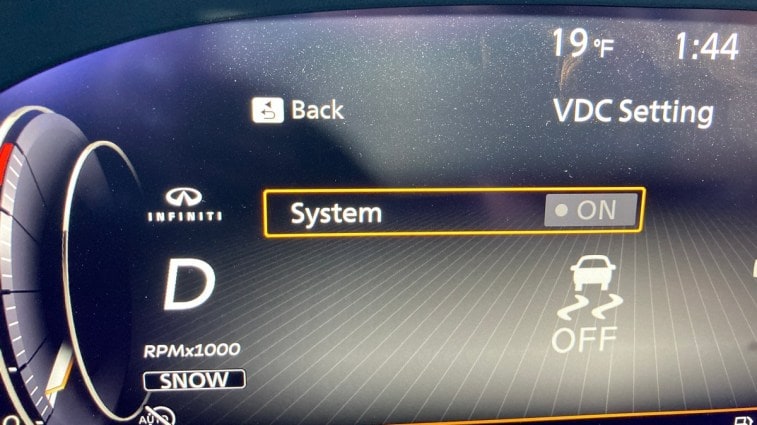
Looking like the silhouette of a car with a couple of squiggly lines in front of it, this orange light activates when the vehicle’s traction control system kicks in. The traction control system works with the antilock brake system to help maintain control of the vehicle when the drive wheels lose grip during acceleration. When it illuminates, the traction control system is doing its job.
13. Antilock Brake System
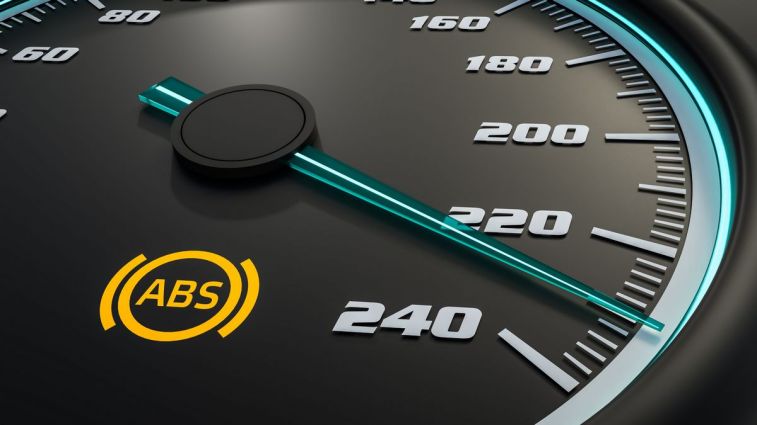
Unlike the red brake system warning light, the antilock brake system (ABS) light alerts that something is amiss within the antilock system itself. It presents as the letters “ABS” surrounded by a circle inside parentheses. The function of the ABS is to modulate the disc brakes automatically during an emergency braking scenario. Although it helps brake the vehicle more efficiently than humanly possible, its primary function is to aid the driver in maintaining control of the car while allowing the vehicle to be steered around danger. The warning light illuminates when there is an issue with that safety system, meaning that the modulating function is not working. It does not signal total brake failure. It’s just that the driver is now on their own in managing an emergency braking event.
PRO TIP: In an emergency braking event, you will probably feel the automatic modulating as a vibration in the brake pedal. This is normal. You should continue depressing the brake pedal.
14. Lane-Departure Warning

Sometimes a silhouette of the rear of a car between two dotted lane-dividing lines, this light activates the signal when the lane-departure feature detects a vehicle wandering out of its lane. Usually, some audible warning also sounds. This signals the driver it’s time to pay attention and center the car in the appropriate lane.
15. Washer Fluid
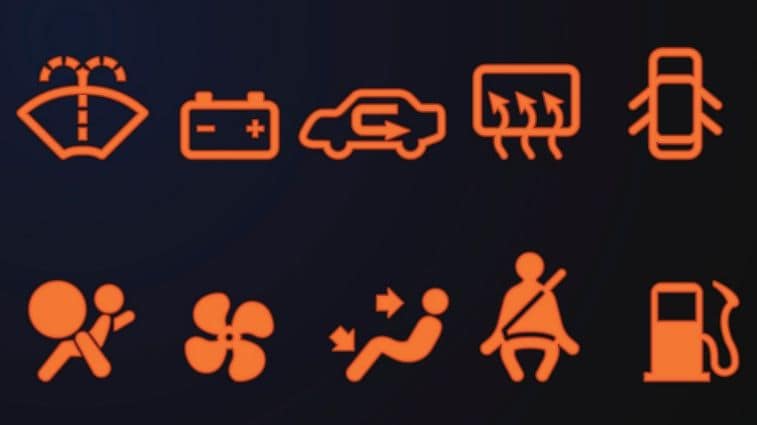
Presenting as the outline of a windshield with the representation of a fountain springing from it, this light warns that the windshield washer fluid reservoir is low or empty, indicating that it’s time to replenish the washer fluid.
16. Automatic Shift Lock
This illuminated icon looks like a shoe surrounded by a circle inside parentheses. Failing to depress the brake pedal when trying to start the car or shift into a directional gear will activate this light. Depressing the brake pedal will extinguish the warning light.
17. Cruise Control
Whether a vehicle has a standard or an adaptive cruise control, when the system is engaged, its functioning light appears as the silhouette of a speedometer. All that means is the cruise control is operational.
18. Turn Signal Indicators
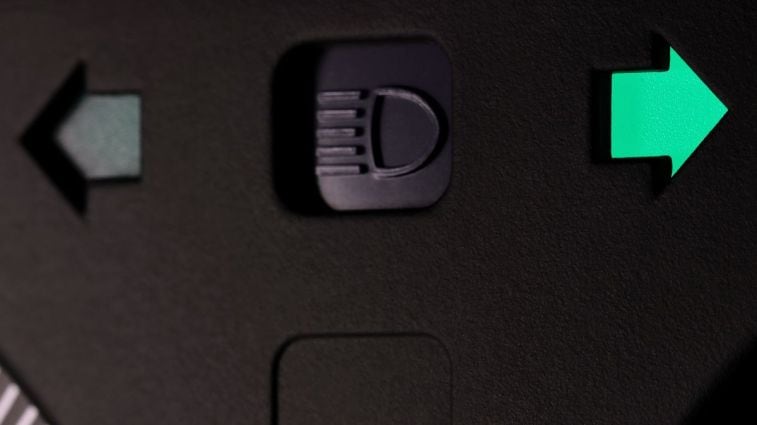
When engaging a turn signal, the appropriate arrow will blink in the direction of the turn. If the arrow remains constant rather than blinking or blinks more rapidly than usual, it likely means a burned-out bulb in the front or rear. Replace the bulb.
19. High-Beam Indicator
When a vehicle’s high beams are engaged, the function light is the silhouette of a headlight with five vertical lines pointed forward. To extinguish the light, deactivate the high beams.
20. Fog Lamp Indicator
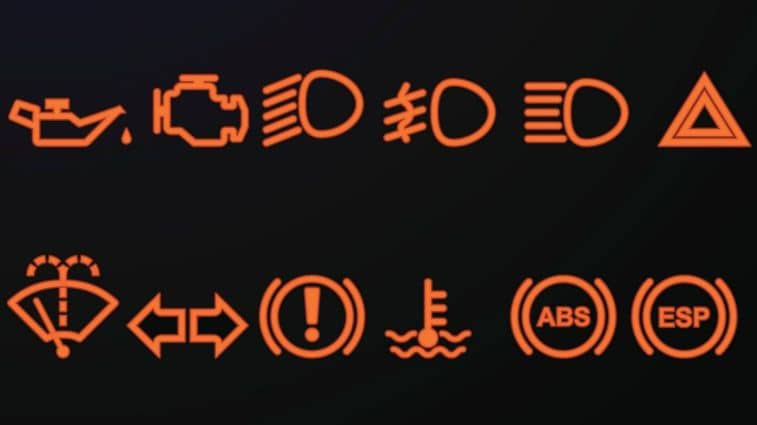
Indicating that the vehicle’s fog lamps are engaged, the function light is shaped like a tilted-down headlight with three vertical lines intersected by a squiggly line. Aimed lower than headlights, fog lights are engineered to point under a patch of fog to illuminate the pavement.
21. Hands-Free Driving Engaged
Several carmakers offer Level 2 hands-free, eyes-on-the-road driving. Such systems allow the driver to turn steering, acceleration, braking, and, for some systems, lane-changing responsibilities over to an automated system for extended periods of time under certain conditions. Each individual system has its own method for alerting a driver that it is engaged.
| Automaker | Level 2 System | Engaged Lighting Alert |
| BMW | Assisted Driving Plus | Green bars on the steering wheel; green steering wheel icon in the gauge cluster |
| Ford/Lincoln | BlueCruise | Blue steering wheel icon in gauge cluster; cluster theme lighting goes blue |
| GM: Cadillac/Chevy/Buick/GMC | Super Cruise | Green light bar on top of the steering wheel; green steering wheel icon in gauge cluster |
| Jeep/Ram | Hands-Free Active Driving Assist | Green steering wheel icon in gauge cluster |
| Lexus | Teammate | Cluster theme color turns blue |
| Mercedes-Benz | Drive Pilot | Steering wheel lights glow turquoise; turquoise light bar on steering wheel |
| Nissan/Infiniti | ProPilot Assist 2.1 | Green steering wheel icon in gauge cluster; illuminated “ProPilot Assist” |
| Tesla | Full Self-Driving (FSD) | Cluster theme color becomes blue |
How to Reset Car Dashboard Lights
Usually, addressing the issue causing a dashboard warning light to activate will deactivate it immediately or after a few miles of driving. If deactivation isn’t automatic, either the problem hasn’t been solved, or you must manually reset the warning lights. Think of it as restarting a computer to reset an issue. First, try turning off and restarting the engine. If that doesn’t solve the problem, try disconnecting the negative (black) battery cable. Hold it away from any metal, wait 60 seconds, and reattach it to the battery. If any warning lights remain on after restarting the engine again, take it to a trained technician for service.
PRO TIP: If you are unsure how to find a technician or mechanic trained to address a dashboard warning light issue, we can help. Check out Kelley Blue Book’s service finder and price estimator site. Based on your vehicle’s year, make, and model, it can provide a list of qualified service centers plus an estimated range of the service cost.
RELATED: Car Maintenance Guide: Everything You Need To Know
